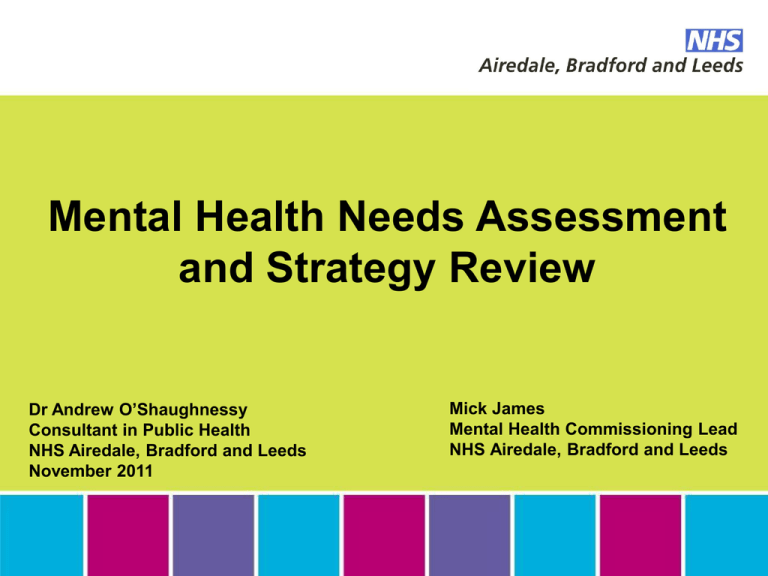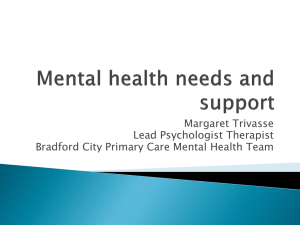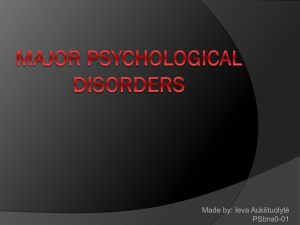Affective Disorders - Building Health Partnerships
advertisement

Mental Health Needs Assessment and Strategy Review Dr Andrew O’Shaughnessy Consultant in Public Health NHS Airedale, Bradford and Leeds November 2011 Mick James Mental Health Commissioning Lead NHS Airedale, Bradford and Leeds Background • Rolling programme of HNAs in Public Health • Began 2008 • Sexual Health, Children, Smoking, Alcohol, Obesity… • Next up Substance Abuse, ASD, Dementia • Process focus on commissioning • Updated annually • Live approach – Observatory Thanks to AL and DC Health Needs Assessment The elements of health care needs assessment Incidence Effectiveness and and/or cost-effectiveness prevalence Strategy Partnerships Commissioning JSNA Prioritisation Reorganisation Existing services Cost-effectiveness allows us to consider the relative priority of different needs Data Issues • • • • • • • • • • Multiple data sources Differing methodologies Differing samples Differing numerator populations Differing denominator populations Data gaps Local improvisation to derive estimates Policy statements Maintains utility NB Observed vs Expected Appendix B Taxonomy Diagnosis • Affective disorders • Bipolar disorders • Psychotic disorders • Personality disorders • Others e.g. suicide Demographic • Gender • Age group • Young • Working age • Older people Overall Burden of Illness Broad Epidemiological Perspective Corresponding Epidemiology in Bradford & Airedale Adults 20% of working-age women are affected by depression or anxiety 29,420 7% of working-age men are affected by depression or anxiety 13,000 3% of women can be assessed as having a personality disorder 5,950 5% of men can be assessed as having a personality disorder 9,500 1.9% have a psychotic disorder such as schizophrenia or bipolar affective disorder during their lifetime 8,530 Children (0-15yrs) 10% of children have a diagnosable mental health condition 11,310 Source: Estimated from New Horizons and ONS mid 2008 population estimates Children 1 Boys (%) Age All 5-16 year olds (%) Girls (%) 5-10 year olds 11-16 year olds 5-10 year olds 11-16 year olds Conduct disorder 6.9 8.1 2.8 5.1 5.8 Hyperkinetic disorder 2.7 2.4 0.4 1.4 1.5 Emotional disorder 2.2 4 2.5 6.1 3.7 Less common disorders 2.2 1.6 0.4 1.1 1.3 Any disorder 10.2 12.6 5.1 10.3 9.6 Source: Mental Health of Children and Young People in Great Britain, ONS 2004 Children 2 Age Range 5-10 years 11-15 years 5-15 years Number of Children Prevalence Number with a mental health disorder Female 21,057 5.1 1,074 Male 22,048 10.2 2,249 All 5-10 43,105 7.7 3,319 Female 17,501 10.2 1,785 Male 18,195 13.1 2,384 All 11-15 35,696 11.7 4,176 All 78,801 9.6 7,565 Source: CAMHS Needs Analysis Review 2007 Older People • There are an estimated 4,080 older people with Bipolar I disorder in Bradford District • There are an estimated 1,912 older people with Personality Disorder in Bradford District • There are an estimated 270 older people with schizophrenia in Bradford District • Affective Disorders: Age group Population (F) Population (M) Any neurotic (F) Any neurotic (M) 65 to 69 9,984 9,038 1,519 604 70 to 74 9,337 7,354 1,139 643 75+ 18278 15507 2514 1180 Total 37,599 31,899 5,172 2,428 Affective Disorders Female ~ 32,000 Male ~29,000 Bipolar Disorders • Lifetime prevalence (i.e. those who have the disorder for at least part of their lifespan) of Bipolar I disorder is approximately 1.3% • Prevalence of Bipolar spectrum disorder (including Bipolar I,II and cyclothymia much less clear but may be between 2.6% and 6.5% • Bipolar spectrum disorders often go unrecognized and undiagnosed – hidden and unmet need Males Females All 0-16 790 770 1560 17-64 3370 2010 5380 >65 2050 2030 4080 Total 6210 4810 11020 Psychotic Disorders • ~1,700 adults of working age and 270 older people with schizophrenia in Bradford District • Larger numbers with schizophrenic disorder • NB broad taxonomy of psychosis 16-64yrs 65+yrs Numbers for Bradford adults (+16yrs) Female 797 153 (95% CI) Male 895 115 All adults 1731 272 Diagnosis Schizophrenic disorder One year Lifetime 2332 (1477 to 3537) 5635 (311 to 9211) Personality Disorders Type of personality disorder Female Male All adults 16-34 35-54 55-74 All 16-34 35-54 55-74 All 16-34 35-54 55-74 All - 527 1630 2312 1554 1706 1247 4622 1524 2235 2911 6757 Avoidant 136 988 88 1245 636 1115 - 1778 831 2104 86 2845 Schizoid 407 - 969 1423 565 131 873 1600 970 131 1883 2845 Paranoid 204 329 - 534 636 1378 83 2133 831 1709 86 2489 Borderline 340 461 - 711 141 1574 - 1778 416 1972 - 2489 Antisocial 340 0 - 356 565 1115 - 1778 970 1183 - 2134 Dependent - - 44 0 353 - - 356 416 - 0 356 Schizotypal 68 66 44 178 - 0 - 0 139 131 86 356 Histrionic - - - - - - - - - - - - Narcissistic - - - - - - - - - - - - 1154 1911 2775 6047 3673 3805 2202 9601 4710 5785 4965 15648 Obsessive-Compulsive Any personality disorder Source: Psychiatric Morbidity survey 2000 (from clinical interviews). N.B crossover with other types of mental illness e.g. OCD vs. OCPD Hospital Admissions • Data were collected from Bradford District Care Trust • 60% no diagnosis code so necessary to estimate total admissions by age and disorder type • 2008 and 2009 (combined) there were 3,291 admissions (~1,600 pa) • Psychotic disorders (n=485 per year) and Affective disorders (371) account for half of all annual admissions to BDCT • Significant numbers of admissions for drug (98) and alcohol (129) dependency • Older people: Dementia is the largest diagnosis type accounting for over 40% of admissions, with affective disorders comprising a further 30% • N.B. admissions elsewhere and “composite” admissions – actual admission burden likely to be higher Hospital Admissions Ethnicity • • • • • • • • People from minority ethnic groups living in the UK are more likely to – Be diagnosed with mental health problems – Be admitted to hospital with mental health problems – Experience a poor mental health treatment outcome. There may also be low levels of reported and diagnosed mental health disorders due to negative stigma. This results in low engagement with services Rates of affective disorders 15-20% higher within the S. Asian pop. of England Black groups have lower prevalence for affective disorders than the general pop African Caribbean people are 3 to 5 times more likely to be diagnosed and admitted to hospital for schizophrenia than other groups. Evidence is inconclusive as to whether South Asian groups have higher rates of schizophrenia than whites, although they have better rates of recovery No relationship between any of the QoF MH indicators and South Asian ethnicity in B&A Those from South-Asian ethnic groups in B&A have higher levels of satisfaction with their financial situation than those from the White group Prescribing • • • • 587,000 prescribed items per year in Bradford District Cost of £5.9 million per year Antidepressants comprise more than half Substantial variation in prescribing across the District Benchmarking 1 • Bradford’s relatively deprived population,compared nationally, may be expected, at the population level, to generally suffer higher levels of bipolar and psychotic disorders • Almost two thirds of those in need receive either enhanced or standard CPA in Bradford, compared to one third in our peers and England as whole • In Bradford District 10,440 people claim mental health incapacity benefit. This is 3.5% of the working age population, compared to 1.7% nationally • In 2008/2009 there were 32,111 patients with diagnosed depression on GP depression registers. This is 6.1% of total patients on lists compared to 7.7% in Yorkshire and Humber and 8.1% in England Benchmarking 2 • The rate of access to mental health services for adults is below our PCT peers and England for older people but above the England average for adults of working age • Bradford has a lower proportion of contacts with psychiatrist / psychologist / psychotherapists, at 14% compared with our PCT Peers at 24% • In Bradford patients are more likely to be admitted than those in contact with services in similar PCTs or in England as a whole • Approximately 1,400 people were detained under the Mental Health Act 1983. The proportion formally detained for at least one day is similar to our PCT peers but above the national average Local Geographic Variation • • • • • • • • Residents from City and South and West Alliance areas were slightly more likely to report feeling downhearted and depressed Levels of life satisfaction are lowest in the South and West Alliance area Substantial variation in QoF prevalence between practices, with greatest variation between practices in the City Care and South and West Alliance Of the 13 practices achieving less than 90% of mental health reviews for patient, 9 are in City Care Alliance. Patients within these practices are also less likely to have a comprehensive mental health care plan or be followed up for non-attendance of 15 months reviews Antipsychotics drug prescribing rates and cost per head of population are similar across the 4 alliances. South and West alliance has the highest prescribing rate (0.16 items per head) with Airedale alliance the highest cost per head (£5.19) However, there is a huge range in prescribing of antipsychotic drugs between practices ranging from 0.02 items per head (£0.41) to 0.6 items per head (£11.40). City Care Alliance has the lowest number of items and cost per patient for antidepressants (£2.14 per head of population) and hypnotics and anxiolytics (£0.86). For hypnotics and anxiolytics, prescribing rates and cost are broadly similar across other alliances S&W alliance has the highest number of items per patient for anti-depressants, although Airedale and YPCA/BANCA alliances have higher costs per patient, suggesting variation in the type and quantity of drugs prescribed by GPs Strategy Review • • • • • • • • Need to review local strategy Changing Commissioning landscape Public Health changes Health and WellBeing Boards Integration Personalisation Joint Commissioning Alcohol, Substance Abuse CCG Context • • • • • Strategic planning Commissioning plans Partnership working Prevention and Management Focused workstreams – IAPT Need/Capacity planning – Antipsychotic prescribing in Primary Care – Antipsychotics in Dementia – Guidance Taxonomy – Autism HNA – Dementia HNA Next Steps • • Complete the HNA triangle In tandem with commissioners as part of MH strategy development: – Analysis of need and service provision with gap analysis – Use of evidence and guidance to identify approaches to address these – Assessment and application of published clinical and strategic guidance on mental health and wellbeing. – Focused review of published research literature as required – Engagement with partners including clinicians in Primary and Secondary Care







